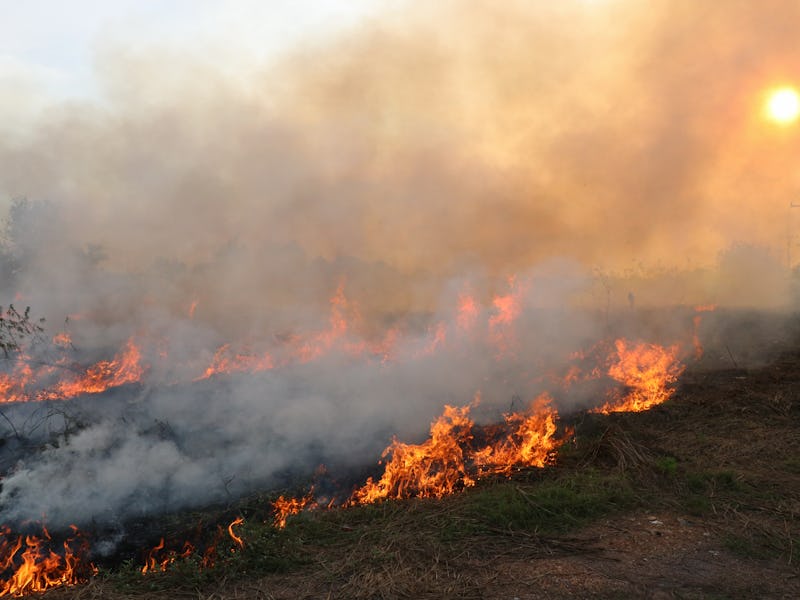One apocalyptic weather combination could happen twice as often by 2100 — study
“Wildfires are going to continue to increase in the future, and so is rainfall.”

Samantha Stevenson moved to Santa Barbara in October 2017. Two months later, the Thomas Fire swept through Ventura and Santa Barbara County, the place she called her new home. Three weeks after that, a rainstorm she describes as “devastating” pounded through, killing at least 21 people with debris flows. The fire had burned away plants and roots, leaving loose soil to erode rapidly when heavy rain came.
“You move to a new city, you don't know anybody and then all of a sudden there's this giant fire and the air is full of smoke and ash is raining down on my car,” she tells Inverse. “It was a shocking welcome to California.” Stevenson says she was in a part of Santa Barbara farthest away from the fires, so while she didn’t have to evacuate her home, she felt the conditions the fire brought, like smoky, ashy air.
Many others still feel the effects of this fire. Stevenson points to Montecito as a community that was hit even harder. Stevenson is just one of the thousands of people to witness this natural disaster.
The Thomas Fire and the rainfall succeeding it is just one event of its kind that inspired a study Stevenson, a climate science professor at the University of California, Santa Barbara, co-authored. She and her team published their findings today in the journal Science Advances, which indicate that climate change could make this vicious cycle of wildfire followed by tempestuous storms more likely as this century progresses.
What’s new — Two climate models discussed in the paper predict that by the mid-21st century in a high warming scenario known as RCP8.5 (Representative Concentration Pathway), there could be an increased likelihood that an extreme fire event will be followed by at least one extreme rainfall event in that year. By 2100, the frequency of these events happening together could double in California, and be more than seven times as likely in the Pacific Northwest. RCP8.5 is regarded as a worst-case scenario in climate change as the planet’s temperature rises.
“In a sense, the results are what we expected,” Stevenson tells Inverse. “We have known for a while that climate change is magnifying the risk of both wildfire and extreme precipitation.” While these two extremes are very rare on their own, the effects of climate change can make both occurrences more likely.
Stevenson stresses that currently, we’re not living the trajectory that RCP8.5 puts us on. “There are some suggestions that we might be, right now, on a trajectory that's somewhat more moderate than RCP8.5,” she says. That may bring some relief, but we’re also still in the early part of the century, so there’s room for fluctuation.
Why it matters — While Stevenson and her team produced a projection under a worst-case scenario, that means that even a more tempered trajectory could produce a higher likelihood of these extreme weather events. They just may not be as likely as their worst-case scenario paper indicates.
Whether the likelihood increases only a little or seven-fold, more events like the Thomas Fire can occur and potentially devastate other communities. The western U.S. is especially vulnerable to this weather, considering these oscillations occur regularly in the region.
Digging into the details — A climate model, Stevenson says, is a big set of equations. There’s an equation for the ocean, for the atmosphere, for the moisture, and so on. Each equation describes how that variable is behaving. Then, depending on the behavior and corresponding equation, the model looks at how all those variables interact with each other. It’s not a set of weather forecasts, but it’s a statistical model that looks at the likelihood of any variable’s behavior, and how that behavior may lead to future events. A climate model can’t predict, for example, when and where exactly a wildfire will strike next, but depending on the information it’s given, it can indicate the likelihood that a fire will occur in a certain region during a certain timeframe.
“By doing that, you're you're able to say, ‘Maybe the fire wouldn't have happened over here, maybe it would have happened over here instead,’ but the statistics of the influence of climate change are going to be consistent across all those simulations.
For instance, hot and dry temperatures — prolonged by increased global temperatures — foster wildfire weather. The longer these conditions last, the longer the fire season can last, and the harder it may be to control the fire.
What’s next — Plants and vegetation play an unassuming yet critical role in this delicate balance. The absence of flora and their root systems gives way to erosion that can lead to landslides and even boulders destroying homes. A large part of how much of a risk the wildfire poses depends on how quickly vegetation can regrow. Stevenson says that if many plants regrow within the first few months after the fire, that’s less worrisome because it stems the risk of debris flow.
The way fires destroy plants is yet another variable to throw into climate models. “Ultimately, next is to try to think about the full spectrum of interactions between fire, rainfall, plant regrowth, and eventually, fine-scale topography.”